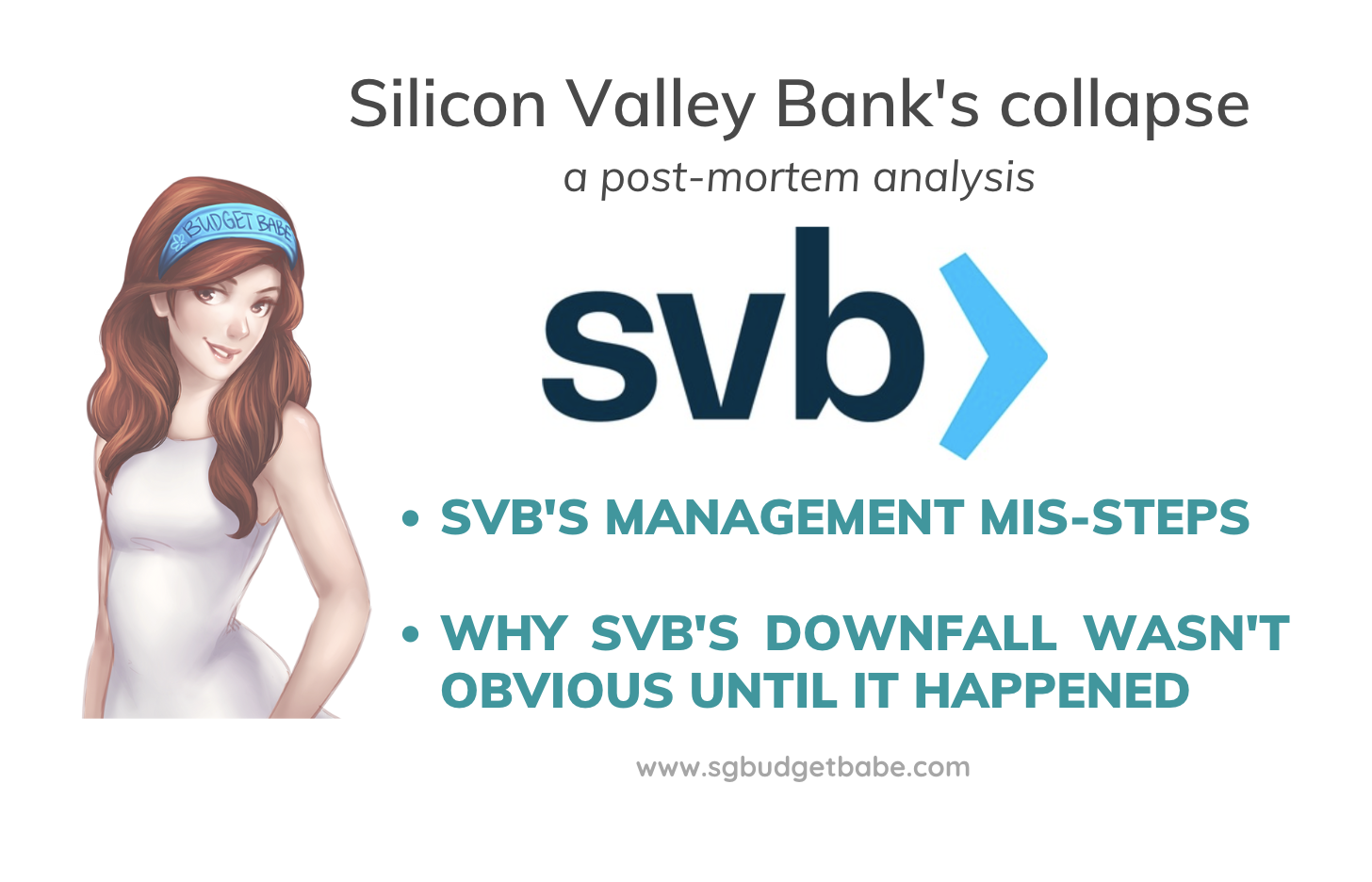An ELI5 abstract of how and why SVB failed, and whether or not there have been any crimson flags that retail traders may have used to foresee this. What can we, as traders, study from this incident?
Spoiler alert: it will have been extremely troublesome. This text examines how, in an alternate actuality, SVB could not have collapsed in any case.
Final week, we watched because the 16th largest financial institution within the US collapsed. Up till final Friday, it was the most popular financial institution for startups and tech corporations, price over $200 billion and was a inventory market darling (having been really helpful by varied “gurus” and funding subscription providers) that benefited from the pandemic.
Till all of it got here all the way down to zero.
SVB seemed to be a darling inventory for many
Silicon Valley Financial institution (SVB) Monetary supplied banking providers to start-ups, who put their funds raised from non-public fairness or enterprise capital corporations into the financial institution and use it for working bills, payroll, and so forth.
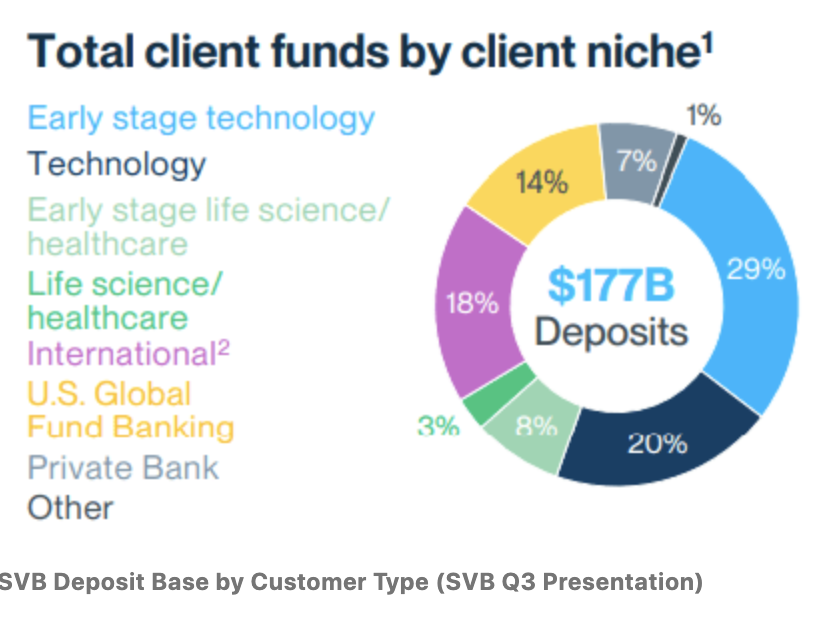
From a enterprise standpoint, SVB delivered large development – from $6 billion in interest-earning property in 2007 to $210 billion in 2022 – an approximate 27% annual development price.
SVB’s development in deposits and loans held regular at 10% – 20% within the years after the International Monetary Disaster. After which from 2018 onwards, the expansion charges accelerated to round 40% CAGR ranges.
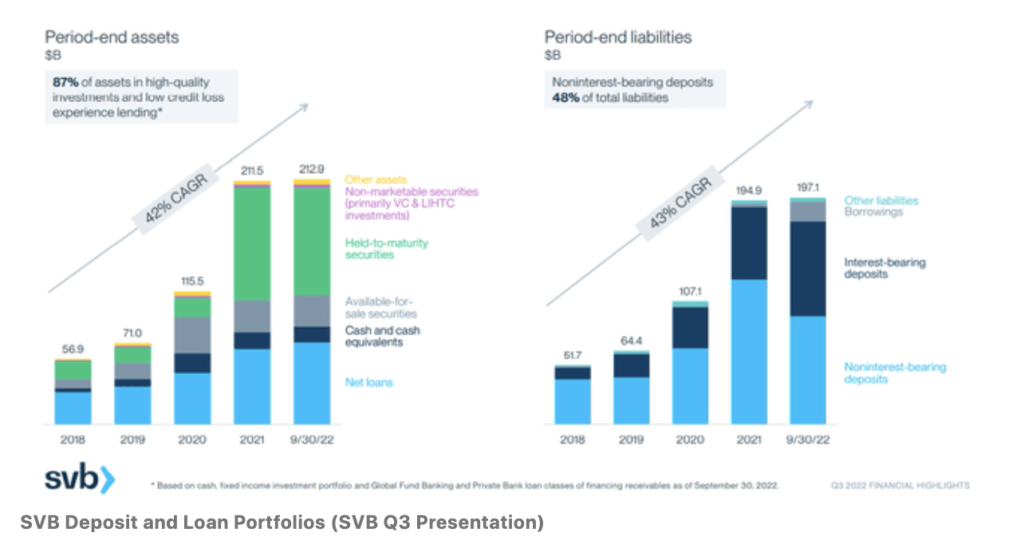
This additionally translated into stable web revenue development for the financial institution:
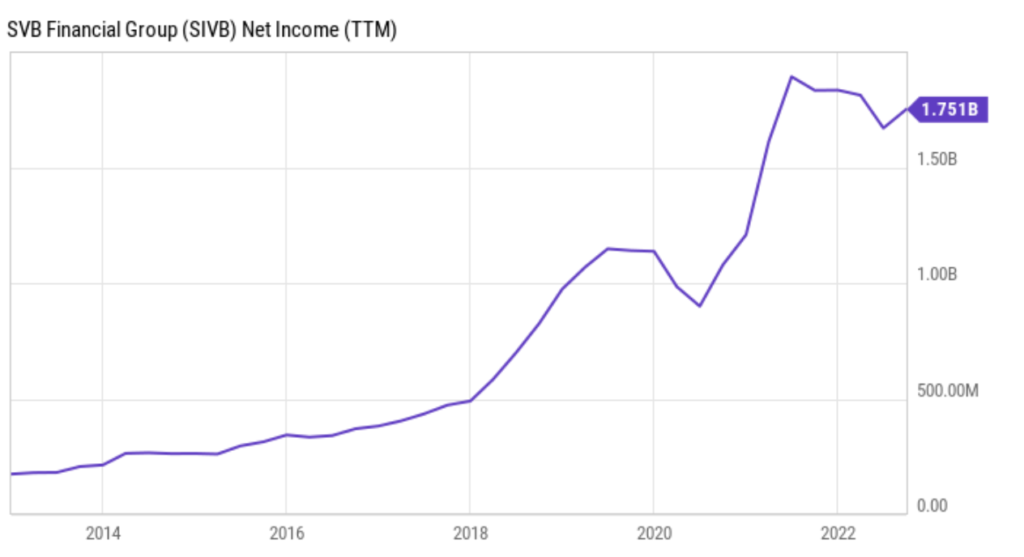
In consequence, SVB’s inventory sometimes traded at a premium to different banks due to its greater development charges and excellent returns. Within the final decade, its return on fairness (ROE) outpaced even banking friends like JPMorgan Chase and Financial institution of America.
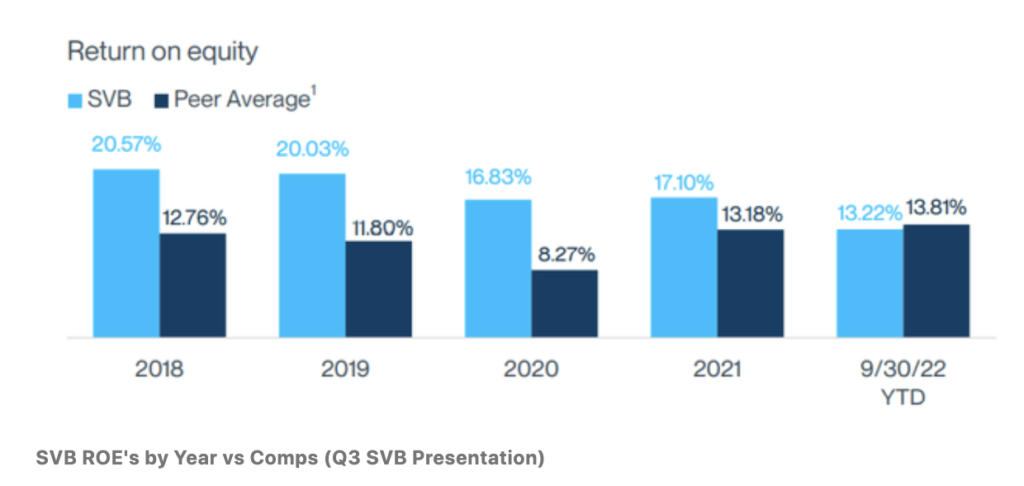
After the subprime mortgage disaster that brought about the collapse of Lehman Brothers, traders have been paying nearer consideration to the loans portfolio of banks. In SVB’s case, administration reassured traders that their loans have been of low threat (though some had their doubts about whether or not a recession would ultimately result in the start-ups who loaned from SVB to default on their funds).
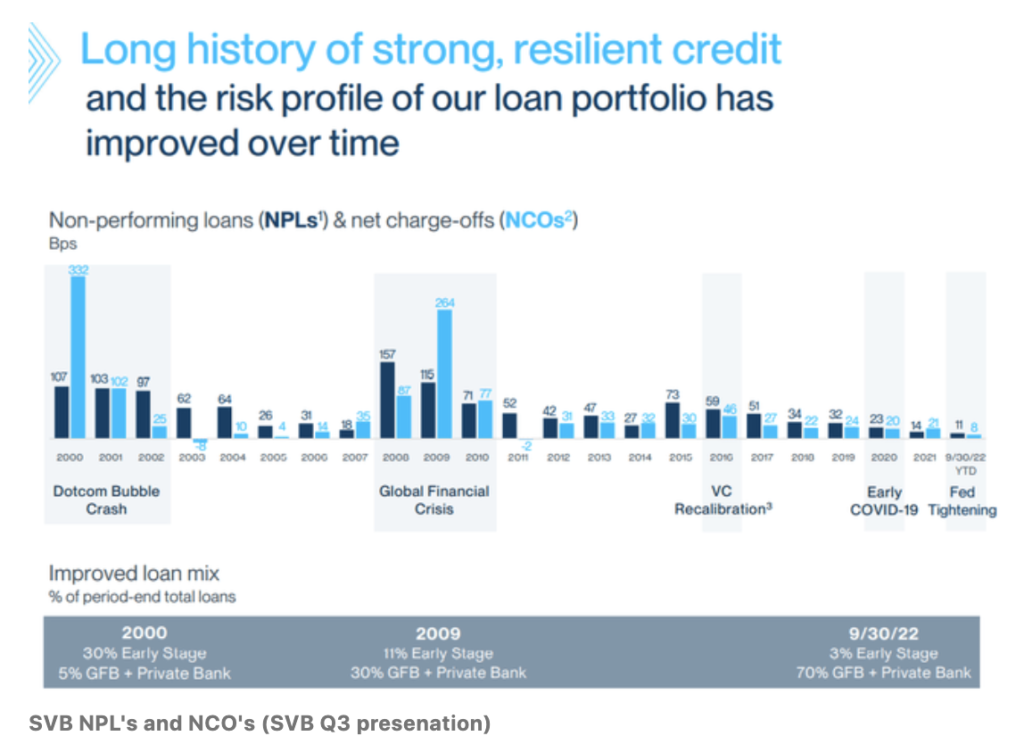
From a credit score perspective, SVB’s loans and bonds have been of a very good credit score high quality; their knowledge confirmed a low likelihood of default. However the crimson flags have been beginning to point out.
In This autumn 2022, SVB disclosed important funding losses, which included a success of $27 million on the sale of $1 billion of US treasury bonds.
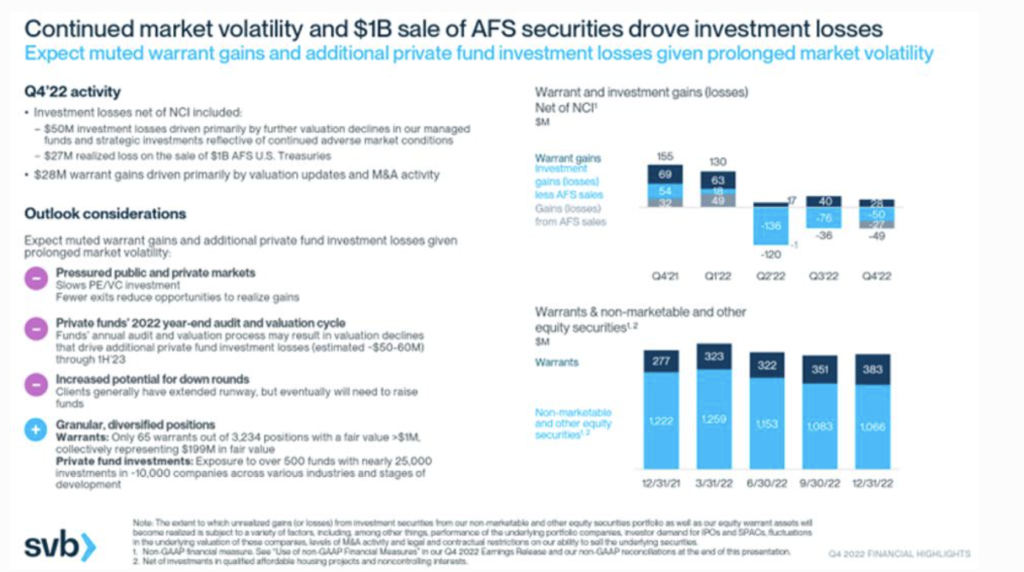
After which in March, the darling inventory crashed inside 24 hours.
How did Silicon Valley Financial institution collapse so shortly?
The way it was potential for such a big financial institution to break down in simply 48 hours, in much less time than what it took for crypto Terra Luna / USDT to go to zero final 12 months?
The first cause for SVB’s speedy collapse (in a minimum of 48 hours) was attributable to a financial institution run.
The secondary cause was attributable to administration’s missteps (I counted no less than 3).
In ELI5 (clarify like I’m 5) communicate, a financial institution run happens when purchasers wish to withdraw extra money from a financial institution than it has out there.
Financial institution run = when clients withdrawing cash > cash out there within the financial institution.
How did the financial institution run out of cash?
Properly, if you and I (depositors) put cash in a financial institution, the financial institution usually pays us (a low) curiosity on it whereas taking our funds to reinvest in monetary merchandise with a better price of return – akin to by loans, equities, mounted revenue merchandise, and so forth.
The distinction between what the financial institution pays us vs. what they earn = their income. And as of December 2022, SVB’s web revenue margin was nonetheless juicy at 22.05%.
However beneath the hood, the truth was that SVB had obtained a lot deposits throughout the previous couple of years (due to the run-up in VC funding by the pandemic) that it wasn’t in a position to mortgage them out quick sufficient.
So, as a substitute of constructing dangerous loans (akin to to debtors with poor credit score however with excessive urgency wants), SVB determined to put money into fixed-income investments – together with long-dated US authorities bonds – which have been a lot safer.
This was a administration misstep, though not but painfully apparent at the moment (given the alternatives).
Now, if rates of interest had remained low, this wouldn’t have been an issue. However then the Federal Reserve determined to boost rates of interest, and so they raised it quick.
Rates of interest went from successfully zero to virtually 5% in lower than a 12 months.
This brought about 2 issues for SVB:
- The upper rates of interest additionally brought about SVB’s mounted revenue investments to drop quickly in worth.
The second administration misstep right here was that SVB didn’t execute rate of interest swaps.
Bonds have an inverse relationship with rates of interest: when charges rise, bond costs fall. Therefore, SVB began seeing enormous losses on its bond portfolio. One technique to cope with that might be to hedge by way of rate of interest swaps, however in its FY2022 monetary report, SVB reported nearly no rate of interest hedges on its huge bond portfolio.
Whereas dangerous, this nonetheless wouldn’t have been an issue in the event that they have been in a position to merely maintain till the bonds mature, as it will get again its capital then. Nevertheless, with low-cost funding drying up, SVB’s clients have been additionally beginning to run into issues themselves, and wanted to withdraw its deposits to maintain their enterprise alive. In consequence, SVB’s deposit base began shrinking considerably, with non-interest-bearing deposits falling by 25% from December 2021 to September 2022.
Within the final quarter, SVB’s non-interest-bearing deposits declined by 36%.
As SVB began working out of liquid funds to satisfy these withdrawal requests, the financial institution had no alternative however to begin promoting its bond investments. However who on earth would wish to purchase bonds with a low 1+% coupon price after they can get a better price T-bill at present? And therefore, SVB needed to promote the bonds at a steep low cost so as to liquidate its locked-up funds.
Then, on 8th March, SVB introduced that it had bought a complete of $21 billion of its investments at a loss so as to meet withdrawal demand, and that it was going to challenge fairness to boost extra capital.
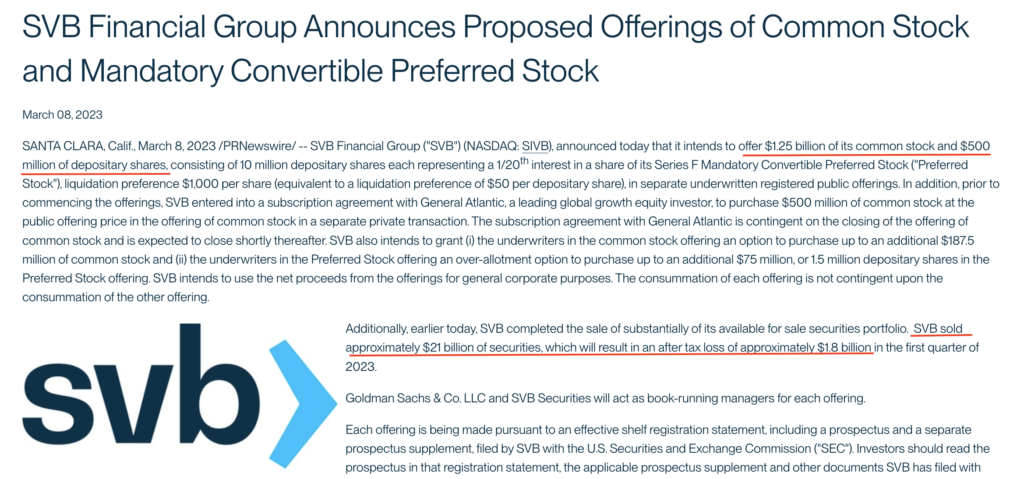
This was the third administration misstep: its communication failure.
In an alternate actuality the place the financial institution had managed its communications higher (and never in such a factual, easy method that clearly brought about depositors to panic), we will solely think about one the place the financial institution run could not have occurred.
However SVB’s announcement spooked depositors, who began withdrawing their capital attributable to worries over the financial institution’s illiquidity. An enormous a part of the panic was additionally as a result of many depositors had greater than $250,000 in SVB accounts, which aren’t insured by the Federal Deposit Insurance coverage Company (FDIC).
Inside 24 hours, practically 25% of all of SVB’s deposits had been withdrawn (9th March).
On 10th March, the financial institution was seized by U.S. regulators and the FDIC ordered its speedy closure.
The entire collapse unravelled in just below 48 hours, making it the largest financial institution failure within the US because the world monetary disaster.
Did the US authorities bail out SVB? No.
It was a painful weekend of ready with bated breath, however on 13th March, regulators stepped as much as assure all of the remaining deposits at SVB (together with uninsured funds) and unveiled a brand new Financial institution Time period Funding Program (BTFP).
The BTFP is designed for banks to have the ability to borrow funds backed by authorities securities to satisfy withdrawal calls for from deposit clients. This prevents banks (within the aftermath of SVB) from being compelled to promote authorities bonds or different property which have been dropping worth attributable to rising rates of interest.
With this transfer, it’s clear that the regulators know that the general public is spooked and try to stop comparable financial institution runs at different establishments.
However solely the depositors are protected; shareholders of SVB and unsecured collectors aren’t.
This was not a bailout. The federal government just isn’t saving SVB – it can keep collapsed and wound up with its remaining property dispersed to clients and collectors.
Now that all of us perceive the backstory of SVB and the way it was potential for such a big financial institution to break down so shortly, what’s extra vital is what we will possbily study from this. Therefore, the larger query right here is:
May retail traders have noticed the crimson flags?
Firstly, let’s be frank and acknowledge that not everyone seems to be able to understanding the (typically convoluted) banks’ monetary statements and notes. If you happen to had checked out its stability sheet, there didn’t appear to be an excessive amount of to be involved about.
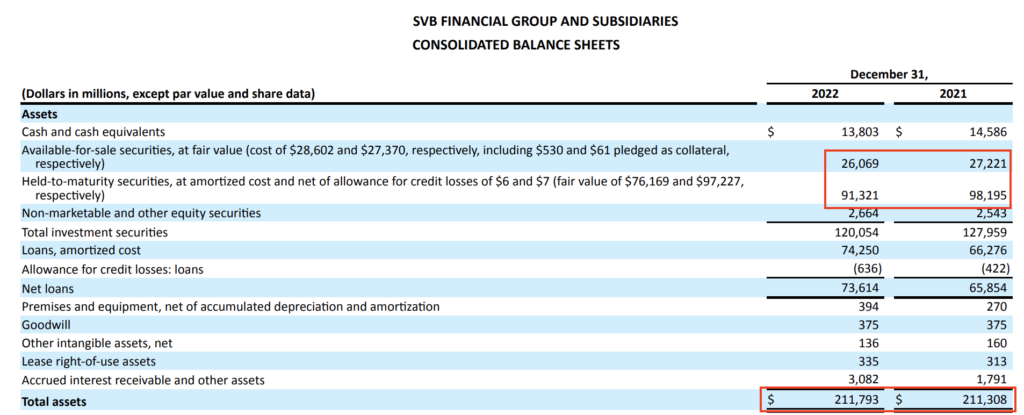
SVB was additionally not required to reprice their Held-To-Maturity (HTM) property primarily based on present market costs except they bought them, so the influence of its declining bond portfolio worth was not solely clear. One may solely guess, however bear in mind, this wouldn’t have been an issue IF the financial institution hadn’t wanted to promote bonds off to satisfy withdrawal calls for.
Just for the sharp-eyed traders who bothered to look deeper into the notes to the monetary statements, web page 125 revealed a US$15.1 billion drawdown. If you happen to had then deducted that from the reported worth of US$91.3 billion on the stability sheet , you can have then realized that the marked-to-market worth of the complete HTM securities portfolio ought to have been US$76.2 billion as a substitute.
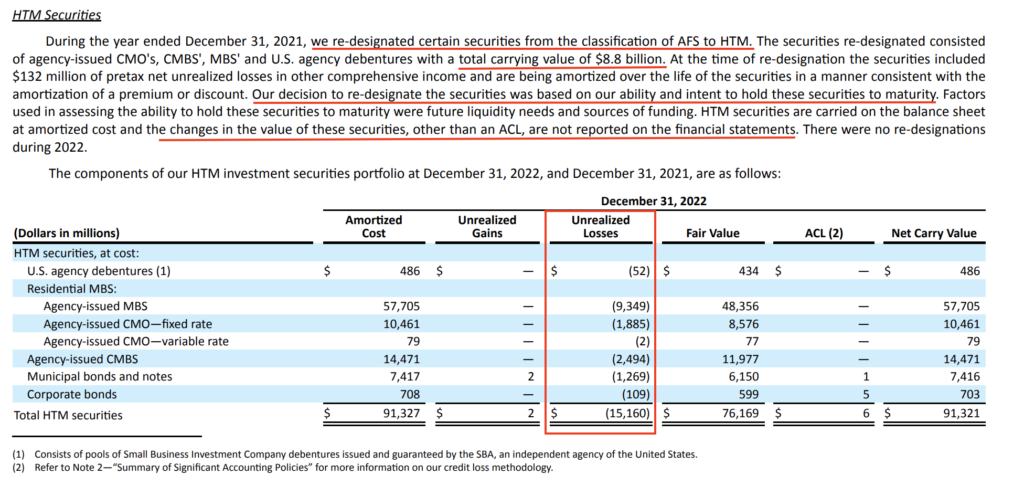
Even with this, you continue to wouldn’t have been in a position to inform if the US$15.1 billion drawdown was because of the HTM property maturing, or for another undisclosed cause. And in the event you appeared deeper, web page 64 reveals you what the HTM property consisted of – not precisely sufficient to set off red-hot warning indicators.
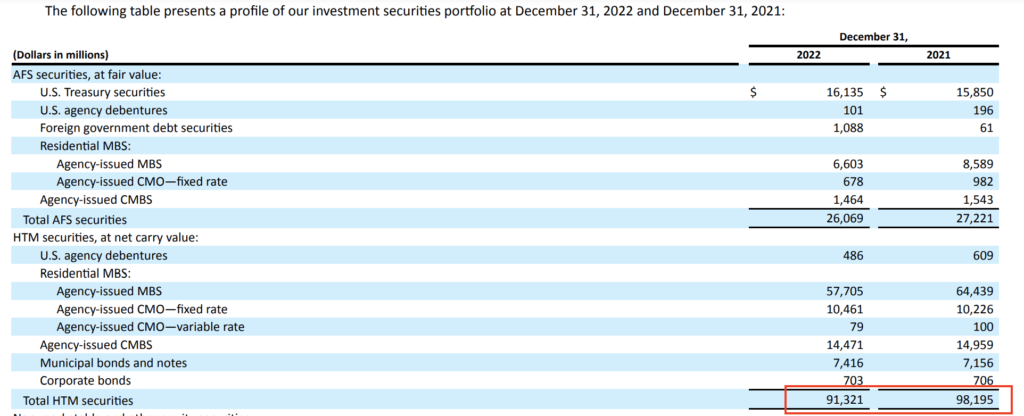
Some folks blame this on the relaxed threat administration necessities for banks below $250 billion in property, which was signed into legislation in 2018 by President Trump (which eased the necessities put in place within the aftermath of the GFC below the Dodd-Frank and the Shopper Safety Act).
In consequence, SVB was not required to reveal how a lot it had in high-quality liquid property to assist it cowl web money outflows (if depositors began withdrawing en masse), so it wasn’t one thing that retail traders may choose up on.
Crucially, this implies there was no technique to know whether or not SVB had sufficient to stop a financial institution run, even when traders have been involved that the start-ups SVB served would possibly begin withdrawing their funds. Dilution of present traders was a extra possible state of affairs (attributable to SVB elevating new capital to fund liquidity wants).
What’s extra, 2 weeks earlier than SVB’s collapse, its CEO Greg Becker bought ~12,500 of his firm’s shares.
I suppose if an investor who had been vested and had been monitoring the corporate carefully, then recognizing the mixture of crimson flags could have helped you to dump earlier than its collapse:
- SVB began reporting a narrowing deposit base since Dec 2021
- SVB’s clients are primarily tech corporations and start-ups, who’ve been shedding staff and began defaulting over the previous 12 months.
- 16.5% of its (HTM) bond portfolio appeared to have declined in a single monetary 12 months. (An indication that solely eagle-eyed traders with information of how HTM asset values work and are reported would be capable to choose up on.)
- The Type 4 submitting displaying SVB’s CEO promoting his shares to web $2.2 million
However even with that, it wasn’t really easy. In any case, the inventory was being touted as “low-cost” by many subscription providers, and till Wednesday, Moody’s and S&P International had Silicon Valley Financial institution as an funding grade issuer – that means SVB had a low likelihood of default and loss severity.
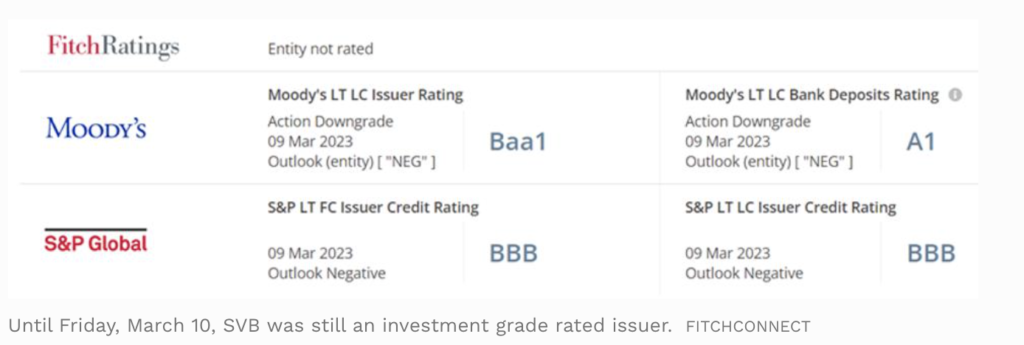
Solely Thursday (after the announcement) did Moody’s and S&P International modified their outlook on the financial institution from secure to destructive.
TLDR (Hindsight Overview):
1. Traders had no technique to know whether or not SVB had sufficient liquid property to stop a financial institution run, attributable to prevailing regulatory reporting requirements.
2. SVB’s declining bond portfolio losses have been additionally unclear, because the financial institution wasn’t required to report it till bought.
3. There have been hardly any obtrusive crimson flags in SVB’s loans portfolio, given the low ratio of non-performing loans.
4. The $2.2 million inventory sale by SVB’s CEO 2 weeks earlier than its collapse may have been a warning signal, however not a conclusive sign.
5. You would need to go towards the prevailing sentiment that SVB was an undervalued, high-quality monetary establishment whose share worth bought battered solely due to the unlucky macro-economic local weather for tech corporations.
6. Even Moody’s and S&P International rated SVB as funding grade i.e. one with a low likelihood of default and loss severity.
So may this have been foreseen? Not precisely.
The best way I see it, SVB’s collapse finally comes all the way down to a mixture of two essential administration errors:
- Investing within the flawed property, after which failing to hedge that as rates of interest rose
- Poor dealing with of SVB’s communications (on 8th March), which spooked its depositors and triggered a financial institution run
Even in the event you have been a savvy investor who may spot #1, nobody may have predicted #2 with accuracy. The truth is, nobody did.
It’s all the time simple to say (with hindsight accuracy) that there have been obtrusive crimson flags that traders missed. However after reviewing all the information and evaluation, I discover that this wasn’t essentially the case with SVB.
As you may see, it will have been troublesome to foretell SVB’s collapse with certainty. As a result of if #2 had been dealt with higher (and also you guys can debate over what that entails, akin to elevating funds from different banks or establishments as a substitute of promoting their bonds, and even tweaking the way in which they made their announcement to make the illiquid scenario much less painfully apparent), a financial institution run could or could not have occurred.
And in that alternate actuality, who is aware of? SVB might need risen from the flames to reclaim its standing as a darling inventory in any case.
Writer’s Observe: I don’t personal shares in SVB and was by no means invested. Nevertheless, this incident undoubtedly raises new studying factors for us traders to be aware of. Whereas watching the disaster unfold, the largest query in the back of my thoughts was whether or not retail traders may have foreseen this, and thus prevented their losses.

